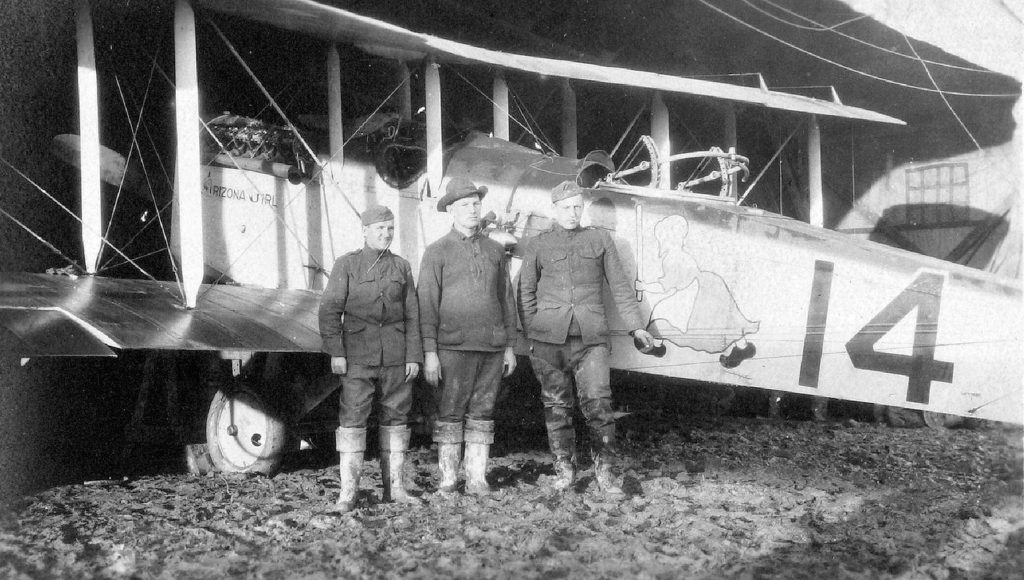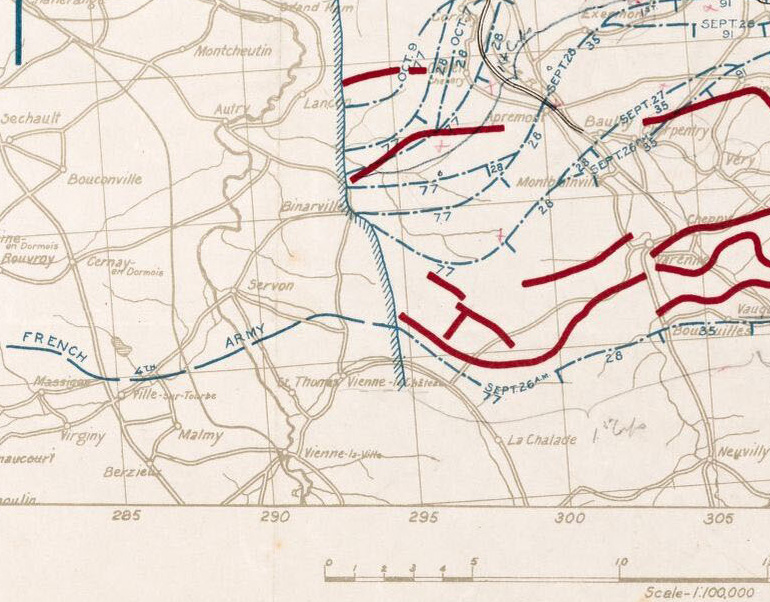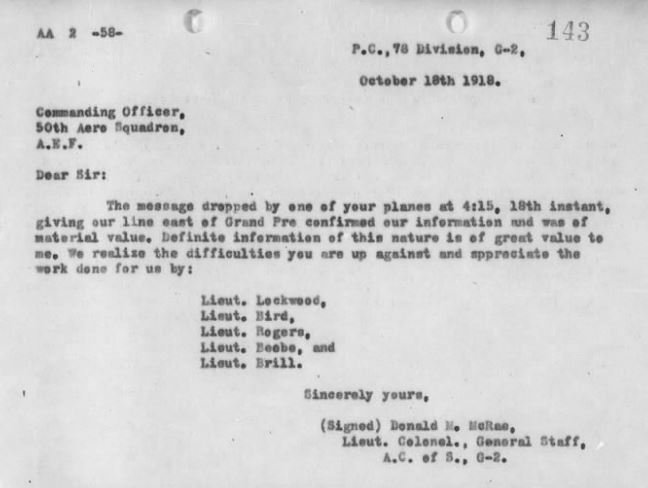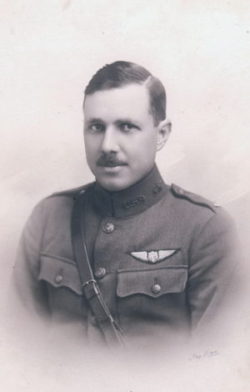(Junction City, New Mexico, August 4, 1891 – Nogales, Arizona, October 16, 1938).1
Training in England: Wyton, Sedgeford, Marske ✯ Training in France; 50th Aero ✯ St. Mihiel ✯ Meuse-Argonne
Tracy, as he was usually called, was named for his father, a Civil War veteran, mining expert, and newspaperman. The senior Bird was from Wisconsin, but spent much of his adult life in the Southwest, including, briefly, a stint in northwestern New Mexico, where Allen Tracy Bird, Jr., was born.2
Bird attended the University of Arizona and in 1911 married a woman he met there, Beulah Oakley Olney.3 He graduated from ground school at the University of Texas on August 25, 1917.4
There were about thirty-six men in Bird’s ground school class; ten chose or were chosen for training in Italy, and these ten were among the 150 men of the “Italian” or “second Oxford detachment” who sailed to England on the Carmania. They left New York September 18, 1917, and arrived at Liverpool October 2, 1917. There they learned that they were not bound for Italy but instead were ordered to Oxford, where they would attend ground school (again) at the Royal Flying Corps’s No. 2 School of Military Aeronautics. There are several passages about Bird in War Birds, starting with an entry dated September 29, 1917: “We have an ex-cowboy with us named Bird, who has been having a terrible time behaving himself.”
On November 3, 1917, Bird was among the approximately 130 men who set off from Oxford for Harrowby Camp, a machine gun training center at Grantham in Lincolnshire. The War Birds entry for November 6, 1917, indicates that Bird was in the running to take charge of the men going to Grantham, but that Elliott White Springs (who was taking a small group to Stamford to begin flight training) thought it prudent to appoint Joseph Frederick Stillman instead: “Somebody has got to hold this crowd down and Bird has been in too much devilment already to be effective on his own responsibility.” However, when fifty of the men left Grantham for flying schools on November 19, 1917, Stillman left “Bird in charge” of those who remained.5
Training in England: Wyton, Sedgeford, Marske

Two weeks later, on December 3, 1917, according to a list drawn up by Foss, Bird was one of eight men sent from Grantham to No. 31 Training Squadron at Wyton, about fifteen miles northwest of Cambridge (the others were Allison Henderson Chapin, Galloway Grinnell Cheston, John Hurtman Fulford, Alfred August Gaipa, Temple Paul Hardin, Francis Kinloch Read, and William Winslow Wait; Earl Adams, Robert Alexander Anderson, Guy Maynard Baldwin, Thomas John Herbert, and Stanley Cooper Kerk were already there).6
By sometime in April Bird was at No. 9 Training Squadron at Sedgeford in Norfolk (it is possible the accident occurred there). Donald B. Cole—who later served with the 135th Aero Squadron—trained with No. 110 Squadron R.A.F. at Sedgeford and took a photo of two men standing next to a DH.9 there, identifying them as Captain [Joseph George] Garneau and “Tracy Bird (Phoenix, Arizona)”10; Garneau was at No. 9 T.S. from April 13 until April 29, 1918.11 In a letter home late in the war Bird mentions that he had become friends with Harold Ernest Goettler when the latter “came to No. 9 squadron at [S]edgeford last spring,” and this is substantiated by passages in Goettler’s diary from this period.12 Most notably, Goettler, in his diary entry for May 19, 1918, recounts how he and several others, including Bird, “were invited to take tea with Lord Leicester at his estate in Holkam [sic; sc. Holkham] Hall a beautiful place” not far from Sedgeford. Ten days later Goettler briefly mentions playing tennis with Bird, and on June 10, 1918, Bird is one of the men sharing a late-night feast in Goettler’s room at Sedgeford.
At 9 T.S. Bird, like Goettler, would have learned to fly DH.4s, the British version of the planes that they would later fly operationally. Bird’s final posting was at Marske-by-the-Sea; he may, like Goettler, have been there only briefly. In early July 1918, he, Goettler, Walter Ferguson Halley, and Claude Stokes Garrett were ordered to travel from Marske to London, preparatory to going overseas.13
Bird was one of a large group of pilots ordered from London to Issoudun, where the American 3rd Aviation Instruction Center was located.14 There he presumably had instruction in flying the American-built DH-4 and in the skills required of an observation pilot.15 In mid-July 1918 he was among a group of nine pilots, including Anker Christian Jensen and Edmond Thomas Keenan of the second Oxford detachment, who were ordered to the 2nd Corps Aeronautical School, an aerial observation school at Chatillon-sur-Seine.16 In August he was assigned to the U.S. 50th Aero Squadron, an observation squadron stationed at that time at Amanty, about thirty miles west-southwest of Nancy, and flying American made DH-4s with Liberty engines. James J. Sloan, Jr., in his Wings of Honor, gives the date of Bird’s arrival at the 50th Aero as August 18, 1918; however, Goettler, in his diary entry for August 31, 1918, wrote “Tracy Bird arrived today.” Sloan goes on to remark that “Only Allen ‘Tracy’ Bird, Bill Frayne and Harry Stevens had flown DH-4s, so they gave flight instruction to the other pilots until they could go on their own—with sandbags in the rear cockpit, just in case.”17 (There were, in fact, some other men familiar with DH.4s and DH-4s, including Goettler, who also assisted with this training.)
In September, in preparation for the St. Mihiel offensive, the 50th Aero initially moved to Behonne (about thirty miles northwest of Amanty), and then, on September 7, 1918, about thirty-five miles back east-south-east, to Bicqueley, south of Toul.
The combined effort of French and American forces to reduce the St. Mihiel salient began early in the morning of September 12, 1918. The 50th Aero Squadron was assigned to work with two divisions of the American First Army, the 82nd and 90th, which were deployed at the eastern end of the south side of the salient. They were to carry out reconnaissance of enemy troops and lines as well as to fly contact patrols to locate American ground troops. The latter were necessary when advancing troops could no longer communicate directly with their divisional headquarters. The troops were supposed to identify themselves to their air support by means such as flares or panels on the ground; the observation squadron would then inform headquarters where the troops were.

During this offensive Bird flew four reconnaissance missions. On the 12th, he and his observer Alfred C. George, assigned to work with 90th Division, were the last plane out (of eight), setting off at 1:20 p.m., flying at an altitude of about 5500 feet about 25 miles north from Bicqueley over the lines into German-held territory around Prény; they did not return until 5 p.m.18 Bird was not among the six pilot and observer teams who went out the next day, but on the 14th he and observer Erwin Russell Bleckley did a two-hour reconnaissance flight in the morning, this time heading somewhat farther east to Eply, and flying at only about 3200 feet. Of this mission Bleckley wrote in his diary: “Up at 7:00 am. Had Breakfast Lt Bird & I left ground at 8:20 am went up to lines on reconnaissance very large activity from Archies saw couple of formation of Bosch machine. We returned about 10:00 am.”19 On the 15th Bird flew with observer James Emerson Sain in the afternoon in the area where American troops of the 90th and 82nd Divisions were advancing to Vandières, and on the 16th he flew an early morning (5:45–7:35 a.m.) reconnaissance with William A. Bolt, initially due north from Bicqueley to Thiaucourt and then over the Moselle as far east as Verny. The squadron continued their work in this area through September 18, 1918. On that day Bird, with Howard Addison Darrin as his observer, went out on a “protection for reglage” mission around noon, flying at 700 meters, but had poor results because of motor trouble and low clouds.20 After the 18th, the 50th was “put on reserve and no missions were made.”21
A few days later the 50th, along with the 1st and 12th Observations Squadrons, was ordered to move—cautiously, to avoid alerting the enemy—to what was now the 1st Corps Observation Group aerodrome near Remicourt (Marne), about fifty miles to the northwest of Bicqueley, to be ready for the Meuse–Argonne Offensive. The 50th was to cooperate with the 77th Infantry Division of the American First Army at the western edge of the American zone.
On the opening day of the Meuse–Argonne Offensive, September 26, 1918, the weather was favorable, and the 50th Aero was able to fly a total of eighteen missions, some of the teams flying a second mission.22 During the St. Mihiel Offensive, they had encountered almost no enemy air activity, but now “our planes met a constant and determined air defense.”23 Bird flew what was apparently his first infantry contact patrol, with Hubert Henry Rogers as his observer. They encountered considerable difficulty during this two-hour mission: infantry could not or would not respond to observers’ requests to show panels or flares. In their efforts to locate the front lines of the 77th, Bird and Rogers had to fly the entire mission at under 900 feet.24 Weather limited the number of patrols for the next two days, and Bird did not fly.25 On the 29th Bird flew another two-hour infantry contact mission with Bolt as his observer and once again had to fly very low in order to identify troops successfully.26
Daniel Parmelee Morse, the 50th’s C.O. and squadron historian, does not provide complete lists of the missions flown by the 50th during the Meuse–Argonne Offensive, so details of many of Bird’s flights are lacking.27 But Morse does record that Bird participated in the attempt to locate and drop supplies to the “Lost Battalion,” nine companies from the 77th Infantry Division that had been cut off in a ravine in the Forest of Argonne in early October 1918 when they advanced more quickly than units on either side of them.28

The afternoon of Saturday, October, 5, 1918, Bird and Bolt, having been sent to Air Service headquarters, went out on a mission to try to spot German batteries. At the end of two hours they reported back and then returned to their own air field. C.O. Morse gave them the evening and the next day off, and they went in search of a long hot bath. On returning to the airfield late the afternoon of October 6, 1918, they found planes from the 50th going out, as Bird wrote to his wife two days later, “with supplies for a battalion that had been cut off in a forest. . . . the C.O. asked us if we wanted to make a trip.”29 Bird and Bolt thus made one of the thirteen missions flown by the 50th Aero that day, setting out in plane number 14 in the late afternoon.30 In the letter to his wife Bird described what happened to them:
. . . at 5 o’clock we got into the air loaded with 250 pounds of food and ammunition. When we got to the lines it was so dark we had to fly 1,500 feet to pick out our way. We circled around over the area where the battalion was, and had just picked out the exact spot where the supplies were to be dropped and started toward it, nose down, a bit and going like he[ll] when the motor began to fail, couple of spark plugs blowin[g] out; so I turned and started going southwest, with motor revolutions dropping slowly, but surely, and we were over the forest, losing altitude every instant, the revolutions dropping [1]00 “reos” [sic] at a time. Finally in desperation, when the “reos” had dropped to 600 (normal flying speed is 1,400 reos) I had to hold the machine in the air at the verge of stalling point, and we got over a couple more kilometers of forest, looking for a place to land all the while. I picked out a spot on a hillside, fairly bare of trees, and came down, sideslipping out of the way of a tree, and pulling up over a line of trench and barbed wire entanglement. Then one wheel alighted in a shell hole, the machine went over on its back, and I found myself resting lightly on my head, safe and sound. But I did not remain on my head long, for the machine showed signs of catching fire, with gasoline pouring out all around me. I loosened my belt and crawled out of a hole which the next morning [I] was unable to get back into. The wires in my helmet connecting the telephones were holding me, and I had to unfasten that before I could get entirely loose. In the meantime [I] was talking to my observer and was relieved to find he was all safe and sound. Then we began to pick our way through barbed wire, abandoned trenches, and brush. In half an hour we had reached a French camp, and they directed us to an American camp. That night we slept at an ammunition dump. . . . Yesterday [October 7, 1918], about 11 o’clock a truck came from our camp (I had got in communication the night before, and reported) and we went up to the wrecked machine and salvaged the instruments, which was a couple of hours work. We reached the camp late in the afternoon.31
Morse reports that Bird and Bolt landed near Vienne-le-Château—near the boundary between the French and American armies.32 Morse also, apparently mistakenly, states that Bird’s plane was brought down by machine-gun fire.33 However, defective spark plugs were a known issue in the DH-4s flown by the 50th Aero, so Bird’s account is certainly plausible.34
At the end of the day on October 5, 1918, the 50th Aero had had sixteen airplanes available. At the end of October 6, 1918, there were six.35 Thus it was that on the morning of October 8, 1918, the “C.O. sent Lieutenant [Francis Clyde] Slater and myself to the aircraft park to bring up two airplanes”; they were presumably going to Colombey-les-Belles, about fifty-five miles southeast of Remicourt. Traveling by truck and train, they reached the outskirts of a village on their route. “As we neared the village another train came along and we decided to get aboard but Slater slipped and fell, one of his feet being caught under the wheels and badly crushed. It was a couple of hours before I could get him to a hospital where his foot was amputated. . . . Yesterday [sic; sc. October 6, 1918] while he was working over the lines a Hun bullet cut through the toe of his shoe just missing his foot.”36
The author of “50th Aero Squadron, Historical Account” (presumably Morse) notes the number and nature of missions flown by the 50th over the next two weeks, but seldom provides the names of the men who flew them. October 18, 1918, is an exception. He writes that on that day Bird and his observer, Rogers, apparently drove down a German biplane, although confirmation was lacking and no official credit received.37 However, Bird and several of his fellow pilots were given credit and thanked by Lt. Col. Donald M. McRae, Assistant Chief of Staff of the 78th Infantry Division, for their work that day in providing information regarding the location of the 78th Division’s lines.38

On or about this date, Bird, now a Flight Commander, was recommended for promotion to Captain “for especially meritorious service at the front.”39 Ten days later, the 50th moved to Clermont-en-Argonne, on the eastern edge of the Forest of Argonne; there they flew missions through November 6, 1918.40
Morse provides a tally of missions and hours flown by the officers of the 50th. Bird’s record shows him to have been among the most active pilots, with twenty missions flown for a total of nearly thirty-seven hours.41
On returning to the U.S., Bird settled in Nogales, Arizona, and for a time managed his father’s newspaper.42 He was serving as Nogales city clerk at the time of his death in 1938.43
Notes
(For complete bibliographic entries, please consult the list of works and web pages cited.)
1 Bird’s date and place of birth are taken from Ancestry.com, U.S., World War I Draft Registration Cards, 1917-1918, record for Allen Tracy Bird Jr. Junction City was the area around the junction of the Animas, La Plata, and San Juan Rivers; it is now Farmington. The photo was taken after Bird was commissioned in March 1918, probably while he was at Sedgeford in Norfolk. It was among a collection of photos handed down in the family to Bird’s great-nephew, the late Henry Leonard Snyder, who posted it to his page for Bird in his (“hlsnyder1”) Snyder Family Tree at Ancestry.com. The photographer was May Bone, who had studios in various towns in Norfolk, including Hunstanton, just a few miles from Sedgeford (see entry for May Bone at Fading Images).
2 “Allen T. Bird.”
3 Ancestry.com, Arizona, Select Marriages, 1888-1908, record for Allen Tracy Jr. Bird; and “Olney-Bird Wedding.”
4 “Ground School Graduations [for August 25, 1917].”
5 Foss, diary entry for November 20, 1917.
6 Foss, Papers, “Cadets of Italian Detachment Posted Dec 3rd.”
7 Cablegrams 652-S and 900-R.
8 “Ak. W.” presumably refers to an Armstrong-Whitworth FK.3 or FK.8.
9 See “Bird, A.F. [sic].”
10 See Cole, “Memoirs of Lt. Donald B. Cole, 135th Aero Sqdn., USAS,” p. 157.
11 See The National Archives (United Kingdom), Royal Air Force officers’ service records 1918–1919, record for Joseph George Garneau.
12 The letter is reproduced in “A Soldier’s Experience.”
13 [Biddle?], Special Orders No. 109, paragraph 27. On Goettler’s time at Marske, see his diary; also Ruffin, “Mortal–Immortal,” p. 143.
14 Coulter, Special Orders No. 105; Biddle, Special Orders No. 109. See also Ruffin, “Mortal–Immortal,” p. 143.
15 Conventionally “DH.4″ refers to the British built, original version of the plane, “DH-4″ to the American built plane with the “Liberty” engine.
16 Benedict, “Special orders No. 194.”
17 Sloan, Wings of Honor, pp. 325 and 316.
18 On Bird’s missions during St. Mihiel, see the operations reports in “50th Aero Squadron, Historical Account,” pp. 81-83; these also appear in vol. 3 of Maurer, ed., The U.S. Air Service in World War I. On Bird’s assignment to work with 90th Division, see Morse, The History of the 50th Aero Squadron, p. 30.
19 Quotation from Bleckley diary courtesy of Steven Ruffin (private communication). The diary is in the National Museum of the U.S. Air Force at Wright-Patterson Air Force Base in Ohio.
20 “50th Aero Squadron, Historical Account,” p. 84.
21 Morse, The History of the 50th Aero Squadron, p. 32.
22 Ibid., p. 35.
23 “50th Aero Squadron, Historical Account,” p. 91. I should note that this remark about enemy activity is part of a passage that in Morse’s The History of the 50th Squadron has been moved to September 30, 1918, rather than September 26, 1918.
24 Morse, The History of the 50th Aero Squadron, p. 35, lists the missions flown on September 26, 1918; “50th Aero Squadron, Historical Account,” pp. 91-92 describes them.
25 Morse, The History of the 50th Aero Squadron, pp. 35-37.
26 “50th Aero Squadron, Historical Account,” p. 93.
27 See both Morse, The History of the 50th Squadron, and “50th Aero Squadron, Historical Account,” which is presumably also by Morse.
28 Morse, The History of the 50th Aero Squadron, pp. 46 and 51.
29 Bird’s letter to his wife is reproduced in “A Soldier’s Experience”; the letter is also the source for the account of Bird’s activities on October 5, 1918. I am grateful to an Aerodrome Forum member for bringing this article to my attention.
30 Durkota, Medal of Honor, p. 13, supplies the plane number. Durkota indicated (private communication) that plane numbers are provided in papers related to the 50th Aero that he consulted at the (U.S.) National Archives.
31 “A Soldier’s Experience.”
32 Morse, The History of the 50th Aero Squadron, describes Bird and Bolt’s mission twice, on pp. 46 and 51. On p. 51 he writes that they “managed to land near La Haragee [sic; sc. La Harazée] and Vienne-le-Chateau.”
33 Ibid.
34 Ruffin, “Mortal—Immortal,” p. 147.
35 Morse, The History of the 50th Aero Squadron, pp. 43 and 53.
36 “A Soldier’s Experience.” It is not easy to establish the exact sequence of the events Bird recounts in this letter, but I believe I am correct that it is his slip when writing on October 8, 1918, that Slater’s near wounding occurred “yesterday.” It has been assumed in some secondary literature (e.g., Hudson, Hostile Skies, p. 267) that Slater’s foot wound was the result of his October 6, 1918, mission. Both Bird’s account and Morse’s ( The History of the 50th Aero Squadron, p. 51) agree that a bullet just missed his foot that day. Ancestry.com, California, WWI Soldier Service Cards and Photos, 1917-1918, record for Francis Clyde Slater gives October 8, 1918, as the date he was wounded. An article (“Santa Ana Men in Casualties”) in the Los Angeles Times from December of that year reported that Slater “lost a foot when the airplane he was piloting crashed into a train”—a reminder, if one were needed, that many grains of salt should be to hand when reading newspaper accounts of the war.
37 Morse, The History of the 50th Aero Squadron, p. 55.
38 “50th Aero Squadron, Historical Account,” p. 143.
39 Morse, The History of the 50th Aero Squadron, p. 55.
40 Morse, The History of the 50th Aero Squadron, pp. 58 ff.
41 Ibid., p. 83,
42 Ancestry.com, 1920 United States Federal Census, record for Allen T Bird Jr.
43 For the date and circumstances of his death, see Eppinga, Nogales, p. 137.

